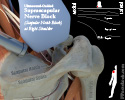II. Indications
- Anesthesia to medial Shoulder (lateral Shoulder would require Axillary Nerve Block)
III. Anatomy
- Suprascapular Nerve originates from C4-6 nerve roots and passes posteriorly through the Scapular notch
- Innervates supraspinatus Muscle and infraspinatus Muscle
- Innervates Glenohumeral Joint and acromioclavicular joint
- Innervates coracohumeral ligament
- Innervates Scapula and subacromial bursa
- Risk of adverse effects on nearby structures
- Suprascapular artery (passes through notch with the nerve)
IV. Preparation
- Identify and mark landmarks
- Scapular Spine
- Skin Preparation (e.g. Chlorhexidine)
- Drape region
- Sterile covering over Ultrasound high frequency linear probe (sterile gel inside and outside)
- Medication
- Confirm maximum dose for Ropivacaine (or Bupivacaine ) to prevent LAST Reaction
- Ropivacaine 0.5% (preferred over Bupivacaine 0.25% to 0.5%) 10-15 ml
- Syringe 20 ml
- Needle 22 gauge, 4 inch (10 cm)
V. Technique
- Images
-
Ultrasound in Transverse Plane, directed inferiorly (toward feet), just posterior to Scapular spine
- High frequency linear probe
- Injection Plane
- Inject from medial to lateral
- Target is within the Scapular notch in the vicinity of the suprascapular nerve
- Avoid injecting into the suprascapular nerve or suprascapular artery
VI. Adverse Effects
- LAST Reaction (as with any Nerve Block)
VII. References
- Reardon and Martel (2020) Regional Anesthesia for Acute Care Conference, attended 12/11/2020
- Combined Suprascapular and Axillary (Circumflex) Nerve Block, NYSORA, accessed 12/21/2020
- Suprascapular Nerve Block, USRA, accessed 12/21/2020
- Suprascapular Nerve Block, Physio-Pedia, accessed 12/21/2020

